
Taipei, June 18 (CNA) Seven Chinese military aircraft, including fighter jets, entered Taiwan's southwestern air defense identification zone (ADIZ) on Thursday, the fourth consecutive day in which such incidents took place.
According to a report from Taiwan's Ministry of National Defense (MND), the Chinese aircraft involved included one Y-8 electric warfare aircraft, two J-16 multi-role fighters and four J-7 lightweight fighters.
Taiwan's Air Force responded by scrambling planes to monitor the Chinese aircraft, issuing radio warnings and mobilizing air defense assets until the Chinese planes left the area, the MND said.
An ADIZ is declared by a country to allow it to identify, locate and control approaching foreign aircraft, but such zones are not considered territorial airspace.
The entries by Chinese aircraft on Thursday come after China sent 28 military planes into the southern part of Taiwan's self-declared ADIZ on Tuesday, a move widely seen as Beijing trying to warn Taiwan's pro-independence ruling party against being emboldened to pushed towards formal independence, after the Group of Seven summit in the U.K. last week issued a communique that noted, for the first time, the importance of maintaining peace and stability in the Taiwan Strait.
Regarding these military activities in general, Lin Ying-yu, an assistant professor in National Chung Cheng University's Institute of Strategic and International Affairs, told CNA that the Chinese military may be testing the interoperability of its aircraft of two different generations, using its own electric warfare aircraft.
The J-7 aircraft were first commissioned in 1967 and are being retired gradually due to ages, while the J-16 entered service in 2015.
Su Tzu-yun, a senior analyst at the government-funded Institute for National Defense and Security Research (INDSR), echoed Lin's view and said the People's Liberation Army (PLA) could be testing J-16's capability against electronic interference.
As to the J-7's appearance in that part of the South China Sea, Su speculated that the PLA might be collecting flight data on sea environment for flight instruments calibration as such aircraft normally do its drills in inland.